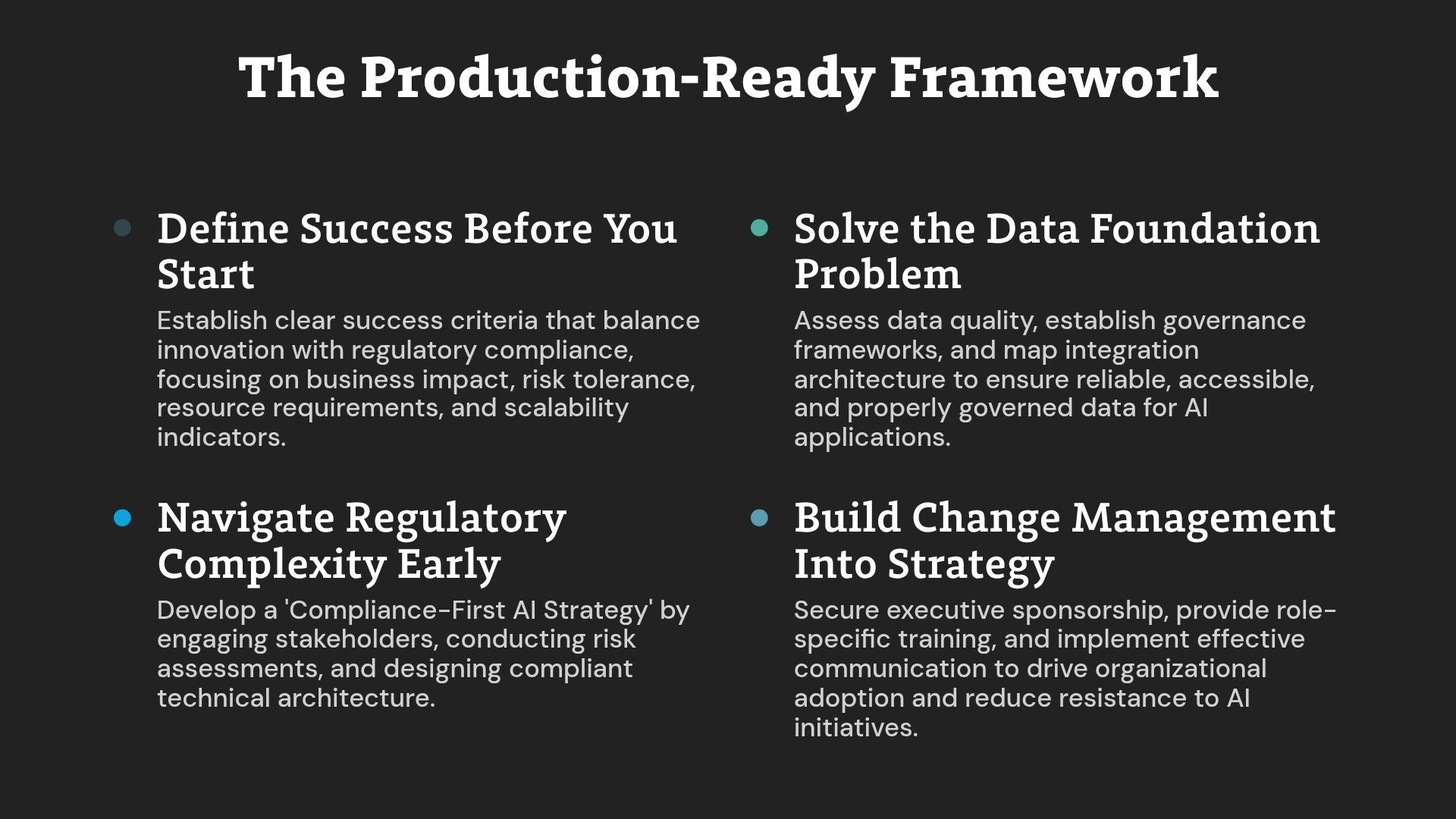The Executive's Guide to AI Strategy: Beyond Pilots to Production
Most executives are drowning in AI pilots that never see production. After helping Fortune 500 companies navigate this exact challenge—including consolidating 1,200+ websites at Novartis while integrating AI for real-time compliance—I've seen the patterns that separate AI success stories from expensive pilot graveyards.
The problem isn't technical capability. It's strategic execution.

The Pilot Trap: Why 73% of AI Initiatives Stall
Three months ago, a pharmaceutical executive called me frustrated. His team had launched seven AI pilots across different departments. Marketing automation showed promising results. Supply chain optimization delivered measurable improvements. Customer service chatbots engaged users effectively.
Yet none had moved to full production.
Sound familiar? You're not alone. Research shows 73% of enterprise AI initiatives never scale beyond pilot phase. The culprits are predictable: unclear success metrics, risk aversion in regulated environments, and the disconnect between pilot results and strategic business objectives.
Here's what I've learned from navigating these challenges across pharma, financial services, and technology companies.
The Production-Ready Framework: Four Critical Foundations
Foundation 1: Define Success Before You Start
Most pilots fail because organizations define success retrospectively. They launch initiatives to "explore AI capabilities" rather than solve specific business problems.
At Novartis, we faced a different challenge: 90 countries, multiple regulatory environments, and compliance requirements that varied by market. Before implementing any AI-powered solution, we established clear success criteria that balanced innovation with regulatory compliance.
The Success Matrix Approach
- Business Impact: Quantified revenue, cost, or efficiency improvements
- Risk Tolerance: Regulatory compliance requirements and mitigation strategies
- Resource Requirements: Budget, timeline, and team capacity constraints
- Scalability Indicators: Technical architecture and organizational readiness
Key Lessons
- Success metrics must align with business strategy, not just technical performance
- Regulatory requirements drive architecture decisions, not limit innovation
- Resource planning prevents scope creep that kills production scalability
Foundation 2: Navigate Regulatory Complexity Early
Regulated industries face unique AI challenges. FDA compliance requirements, data privacy regulations, and patient protection standards can't be afterthoughts—they must inform strategy from day one.
During my Novartis tenure, we developed what I call "Compliance-First AI Strategy." Instead of viewing regulatory requirements as barriers, we made them design constraints that drove better solutions.
The Regulatory Integration Process
- Phase 1: Stakeholder Alignment (Weeks 1-2): Engage legal, regulatory, compliance, medical affairs, and patient services teams before technical development begins. This wasn't standard practice at Novartis, but it prevented expensive late-stage rework that would have required complete project redesigns.
- Phase 2: Risk Assessment (Weeks 3-4): Conduct comprehensive risk analysis across data handling, algorithmic decision-making, and patient impact scenarios. Document mitigation strategies for each identified risk category.
- Phase 3: Compliance Architecture (Weeks 5-6): Design technical architecture that enables AI functionality while maintaining full regulatory compliance. This includes audit trails, explainable AI requirements, and data governance protocols.
What to Do Next
- Identify your regulatory stakeholders and schedule alignment meetings
- Create compliance requirements matrix before selecting AI vendors
- Establish audit trail requirements for explainable AI decisions
Foundation 3: Solve the Data Foundation Problem
AI initiatives fail when organizations underestimate data preparation requirements. Clean, accessible, properly governed data isn't a technical nice-to-have—it's the foundation that determines whether pilots can scale.
Most executives discover this reality after launching pilots with sample datasets, then hitting walls when connecting to production data systems.
The Data Readiness Assessment
- Data Quality Audit: Assess completeness, accuracy, and consistency across source systems. One healthcare client discovered 40% of customer records contained incomplete information that rendered AI insights unreliable.
- Governance Framework: Establish data access controls, privacy protections, and usage policies that support AI applications while maintaining compliance standards.
- Integration Architecture: Map data flows between existing systems and proposed AI solutions. Identify technical dependencies and potential bottlenecks early.
Key Lessons
- Data preparation typically requires 60-80% of AI project resources
- Governance policies must be established before pilot launch, not during scaling
- Integration complexity increases exponentially with each additional data source
Foundation 4: Build Change Management Into Strategy
The most sophisticated AI solution fails without organizational adoption. Technical success means nothing if teams resist using new capabilities or revert to familiar processes.
At Bottom Line Strategy Group, we implemented marketing automation that delivered 28% revenue growth—but only after addressing team concerns about job displacement and providing training that demonstrated AI as an enhancement tool, not a replacement system.
The Adoption Strategy Framework
- Executive Sponsorship: Secure visible leadership commitment that extends beyond budget approval to active participation in change management efforts.
- Team Training: Develop role-specific training programs that demonstrate AI value rather than just technical functionality.
- Success Communication: Share pilot wins across the organization to build momentum and reduce resistance to broader implementation.
What to Do Next
- Identify potential resistance points and address concerns proactively
- Create role-specific value propositions that show career enhancement, not displacement
- Establish feedback loops that incorporate team input into solution design

The Decision Framework: When to Scale, When to Pivot
Not every pilot deserves production investment. Use this framework to evaluate scaling decisions objectively:
Technical Readiness Checklist
- Performance Standards: Does the solution meet defined accuracy and reliability requirements?
- Integration Capability: Can it connect seamlessly with existing systems and workflows?
- Scalability Architecture: Will performance remain stable under production load?
Business Value Assessment
- ROI Projection: Does expected return justify full implementation investment?
- Strategic Alignment: Does the solution advance core business objectives?
- Competitive Advantage: Will implementation create differentiated market position?
Risk Management Evaluation
- Regulatory Compliance: Have all compliance requirements been validated?
- Data Security: Are privacy and protection standards fully implemented?
- Business Continuity: What happens if the AI system fails or requires maintenance?
Workshop Methodology: The Strategic Implementation Process
Based on successful transformations across multiple industries, I've developed a combination approach that addresses assessment, decision-making, and stakeholder alignment simultaneously.
Phase 1: Diagnostic Assessment (Days 1-2)
- AI Readiness Evaluation: Comprehensive assessment of technical infrastructure, data maturity, team capabilities, and organizational culture. This isn't just a technical audit—it's a strategic evaluation of readiness for AI-driven transformation.
- Stakeholder Mapping: Identify champions, skeptics, and key influencers across the organization. Understanding political dynamics prevents implementation roadblocks that kill even successful pilots.
- Current State Analysis: Document existing processes, systems, and performance baselines. Establish clear measurement criteria for improvement evaluation.
Phase 2: Strategic Planning (Days 3-4)
- Decision Tree Process: Systematic evaluation of pilot candidates using the technical, business, and risk criteria outlined above. This prevents emotional decision-making that leads to resource waste on low-impact initiatives.
- Resource Allocation Planning: Realistic budget, timeline, and team requirement projections based on similar implementations. Include contingency planning for common challenges like data integration delays or stakeholder resistance.
- Success Metrics Definition: Establish quantified measurements that align AI outcomes with business objectives. Avoid vanity metrics that create false confidence in pilot performance.
Phase 3: Stakeholder Alignment Workshop (Day 5)
- Cross-Functional Buy-In: Facilitate alignment between technical teams, business stakeholders, and regulatory/compliance groups. Address concerns proactively rather than discovering conflicts during implementation.
- Communication Strategy: Develop messaging that addresses different stakeholder priorities. Legal teams care about compliance, operations teams focus on efficiency, executives want business impact.
- Implementation Roadmap: Create phased approach that balances quick wins with strategic long-term objectives. Include milestone checkpoints that enable course corrections without derailing progress.
Risk Management for Regulated Industries
Pharmaceutical companies, financial services, and healthcare organizations can't afford AI failures that impact customer trust or regulatory standing. Here's how to manage risk without stifling innovation:
FDA Compliance Integration
- Algorithm Transparency: Implement explainable AI capabilities that provide clear reasoning for automated decisions. Regulatory bodies increasingly require algorithmic transparency for patient-facing applications.
- Clinical Validation: For healthcare applications, establish validation protocols that demonstrate AI recommendations align with accepted medical standards and improve patient outcomes.
- Audit Trail Requirements: Design systems that maintain complete records of AI decision-making processes, including data inputs, algorithmic reasoning, and outcome tracking.
Data Privacy Protection
- Patient Data Security: Implement privacy-by-design principles that protect sensitive information while enabling AI functionality. Consider federated learning approaches that train models without centralizing sensitive data.
- Consent Management: Establish clear consent protocols for AI-powered data usage that comply with GDPR, HIPAA, and other relevant privacy regulations.
- Cross-Border Compliance: For global organizations, address varying privacy requirements across different jurisdictions without compromising AI effectiveness.
Business Continuity Planning
- Failover Procedures: Design backup processes that maintain business operations if AI systems experience downtime or performance degradation.
- Human Oversight Integration: Establish human review protocols for critical AI decisions, particularly in areas affecting patient safety or financial transactions.
- Performance Monitoring: Implement continuous monitoring that detects AI performance drift before it impacts business outcomes or regulatory compliance.

Measuring Production Success
Moving from pilot to production requires different success metrics. Pilot metrics focus on technical performance and proof-of-concept validation. Production metrics must demonstrate sustained business value and organizational impact.
Business Impact Measurements
- Revenue Attribution: Track direct revenue impact from AI-powered initiatives. This includes increased sales conversion, improved customer retention, and expanded market opportunities.
- Cost Optimization: Measure operational cost reductions through automation, improved resource allocation, and enhanced decision-making efficiency.
- Risk Mitigation: Quantify reduced risk exposure through improved compliance monitoring, fraud detection, or quality assurance capabilities.
Organizational Transformation Indicators
- Adoption Rates: Monitor actual usage statistics rather than deployment metrics. High adoption rates indicate successful change management and genuine value delivery.
- Process Improvement: Assess workflow optimization, reduced manual effort, and improved decision-making speed across affected business processes.
- Cultural Shift: Evaluate organizational comfort with AI-powered tools and proactive identification of new AI application opportunities.
Strategic Competitive Advantages
- Market Differentiation: Measure competitive advantages gained through AI capabilities that competitors cannot easily replicate.
- Innovation Velocity: Track accelerated product development, improved time-to-market, and enhanced customer experience delivery enabled by AI integration.
- Scalability Achievement: Assess ability to expand AI applications across additional business areas, markets, or use cases without proportional resource increases.
Next Steps: Building Your AI Strategy
The difference between successful AI implementation and expensive pilot programs comes down to strategic execution. Organizations that move beyond pilots to production focus on business value rather than technical fascination.
Start with these immediate actions
- Week 1: Conduct honest assessment of current AI pilot performance using the technical, business, and risk criteria outlined above.
- Week 2: Engage regulatory and compliance stakeholders to understand constraints that must inform scaling decisions.
- Week 3: Define quantified success metrics that align AI outcomes with strategic business objectives.
- Week 4: Develop comprehensive change management strategy that addresses organizational adoption challenges.
Remember: AI strategy isn't about technology—it's about transformation. The companies winning with AI aren't those with the biggest budgets or most sophisticated algorithms. They're organizations with clear strategic vision and systematic execution approaches.
The future belongs to enterprises that can move from AI experimentation to AI advantage. The question isn't whether AI will transform your industry—it's whether you'll lead that transformation or react to competitors who do.
Ready to move beyond pilots to production? The strategic framework exists. The technology is proven. The competitive advantage awaits systematic execution.
Author: William Flaiz










